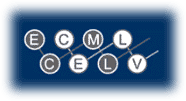
Report on the findings of the
“Quality Questionnaire” on teacher perceptions
of the quality of private language teaching
in six Eastern European countries (2001-2002)
Zoltán Benedek Gráf
![]()
CONTENTS
A. Criteria that are “Excellent”
C. Criteria that “need to be worked on”
A. Happy findings
B. Unhappy findings
![]()
I would like to thank Galya Mateva (Bulgaria), Asenka Kramer (Croatia), Maria Matheidesz (Hungary), Anna Kolbuszewska (Poland), Laura Muresan (Romania) and Vanda Perovic (Federal Republic of Yugoslavia) for their enthusiastic help and support in this project.
Within the framework of the ECML Project on “Quality Assurance and Self-assessment for Schools and Teachers”, the first Regional Workshop (convened in Bucharest, Romania in the autumn of 2000) covered quality management issues in language teaching in a wide sense, including state as well as private education. The private education sector of each participating country was represented by the respective national language school association. The state sector was represented by teachers and ministry officials. The workshop was attended by representatives from both Eastern and Western Europe.
During the discussions it became clear that there are some rather fundamental differences between the language teaching traditions of European countries, especially with respect to whether it is an evident part of state-provided education, as in The Netherlands, for instance, or whether it is to a great extent provided by private language schools, either as an optional supplement to the existing state school education or as an alternative. It appeared that in most Eastern European countries, especially in recent decades, state education has not been able to fully satisfy the language learning demands of the population, which has offered greater business opportunities to private language schools than in countries where state education is able to meet this demand better. Nevertheless, in some countries in Western Europe the situation is similar to that in Eastern Europe.
As a result of the discrepancy between supply and demand, the size and the number of private language schools have increased dramatically in Eastern Europe. A side-effect of the emergence of free competition and good business opportunities in newly (and completely) liberalised markets inevitably led to the appearance of self-appointed entrepreneurs, some of whom opened “trick” schools with low professional standards and poor customer service, either because they themselves were not professionals, or because they were only interested in the quick returns of their investment (or both). In self-defence against the threatening business power of such “trick” schools, “quality” schools in most countries joined forces and formed their professional chambers or associations. The primary role of these is to ascertain the quality in good schools and recognise high-quality work by awarding a registered trademark (logo) to the school, so that professionals as well as customers are informed that the language school that holds such a logo has been through a quality inspection procedure and passed.
At the Workshop in Bucharest it seemed that in Eastern Europe there was a difference in the status of quality assurance work between state and private schools. Most state schools in Eastern Europe are fighting financial problems and it is common practice for some of their language teachers to seek better paid jobs in private schools. In some situations, even in economically relatively strong Hungary it is not uncommon that a state school encounters serious problems finding qualified language teaching staff for the salaries they can offer. Professional standards and quality assurance issues, on the other hand, cannot be addressed before a permanent and devoted staff is available. (This is not to say, of course, that all state language education provides poor quality!) In private schools, however, control and maintenance of quality has gradually been recognised as a major ingredient of business success. (Again, this is not to say that some “trick” schools do not continue to provide poor quality!)
The need to distinguish high-quality schools from others in the private sector has led to serious professional work aimed at creating quality verification systems. This induced thinking about definitions of quality, and brought about what are now widely known as accreditation systems, consisting of “quality criteria”. These are lists of statements about how things “should be” in what professionals consider an ideal language school, against which the actual situation in a particular language school can be measured. To get accredited as a quality school, a language school must satisfy a certain number of these at a certain level.
The representatives of Eastern European private language schools assembled for a section meeting at the Bucharest workshop and discussed possibilities of co-operating in order to share experiences of the work that has been done on quality systems in each country. They decided that a very interesting study could be carried out in order to see whether teachers who work in accredited schools actually sense any difference in the quality of their school from those who work in non-accredited ones.
This entailed the creation of a “quality questionnaire” to teachers, to see how they evaluate their own school. It was thought that once they were administered in several countries, we would be able to see how much “better” accredited schools are according to the opinions of the teachers.
After the Bucharest workshop, intensive networking began in order to create such a questionnaire. After circulating preliminary versions, and the inclusion of many of the participating organisations’ suggestions, a final version was put together.
It was clear from the beginning that such a large-scale, international collection of data is only possible with the help of the national associations and their member schools. It was evident that the schools’ leaders would have access to the filled-in questionnaires, and that it was against the business interests of any school to pass on unfavourable opinions about themselves, therefore a data collection system had to be created which provided anonymity not only for the respondents but also for the schools. For this reason teachers were asked not to write anything by hand (only circle answers), and school leaders were instructed to return the filled-in questionnaires in blank envelopes, without naming themselves as senders.
The questionnaire begins with the most crucial three questions, identifying whether the school from which the questionnaire is returned is a member of an association and, if so, an accredited one or not. This is followed by 35 questions (or, more precisely, statements) inquiring about various things in the school.
In fact, the items were based on the criteria used in quality inspections. They cover the areas of organisation, customer service, professional management, availability of teaching aids, technical facilities and the physical environment. Each statement has an underlined part. Respondents were asked to decide whether the statement was (A) true of their school including the underlined part, (B) true without it, or (C) not true at all (“we don’t have that sort of thing”):
“In my school there is an efficient system for dealing with complaints.” (Item 5)
The idea was that if (A) was marked, it was a sign of high quality, if (B) was marked, it meant that something of the sort was present but the informant did not think it was particularly high quality, and if (C) was marked, it was a sign that the required criterion did not exist.
When the evaluation was done, A’s were worth 1 point (100%), B’s half a point (50%) and C’s zero. When calculating averages, a percentage result was produced, which was the average of the 100’s, 50’s and zeros.
Another question was the language in which the respondents received the items. Because we did not wish to limit the respondents to English teachers it was suggested that the items should be translated into the respondents’ native language. This was done in the case of Hungarian, but not in the case of other languages, which meant that respondents in Yugoslavia, Croatia, Bulgaria, Poland and Romania were either English teachers or fairly good speakers of English.
Within about a year, 309 forms were returned from 6 countries. The number of respondents varied between 21 and 83 from each country:
|
Country |
Respondents |
|
Bulgaria |
83 |
|
Croatia |
21 |
|
Hungary |
77 |
|
Poland |
43 |
|
Romania |
55 |
|
Yugoslavia |
30 |
|
The number of respondents from each country. |
|
While the total number of responses may appear impressive, it must be said that the survey, unfortunately, can in no way be considered representative. Because respondents were asked not to identify either themselves or their school, there was no way of seeing how many schools in each country took part in the survey. It could easily be the case that in a country from which, say, 30 questionnaires were returned, all came from one and the same school, and facts about the remaining schools will not be represented. It is not possible, either, to draw conclusions about the quality of language teaching in a given country which is represented by only one (or, for that matter, two, or three) language schools.
The only sense in which this survey can be called representative is a regional one. It can be argued that averages drawn from the data coming from these countries reveal facts or trends characteristic of private language teaching in the Eastern European region.
Unfortunately, the questionnaire also failed to achieve its primary goal, which was to highlight differences between accredited and non-accredited schools. To the first two questions the answers were the following:
|
Is
your school a member of the national association of language schools?
|
Is
your school certified or accredited for quality services by a national
union or organisation?
|
|||||
|
Yes |
No |
Not answered |
Yes |
No |
Not answered |
|
|
Bulgaria |
37 |
11 |
35 |
22 |
25 |
36 |
|
Croatia |
20 |
0 |
1 |
18 |
2 |
1 |
|
Hungary |
73 |
1 |
3 |
52 |
22 |
3 |
|
Poland |
35 |
1 |
7 |
36 |
0 |
7 |
|
Romania |
27 |
23 |
5 |
29 |
23 |
3 |
|
Yugoslavia |
26 |
1 |
3 |
20 |
2 |
8 |
Clearly, many of the respondents in Bulgaria could not or did not wish to answer the questions about membership / accredited membership of their schools in their national associations. The reason may be that private language schools there formed their national association quite recently, which may have meant that respondents were not yet aware of its existence.
Looking at the other countries, it is clear that nearly all of the respondents belonged to member schools of the national associations, which is not surprising because it was the associations themselves that helped in circulating the questionnaires. Naturally, the associations have little or no access to schools outside their membership. Still, because membership in these organisations is voluntary (and costs a fee), not all private schools are members – in fact, most are not. This is yet another factor that imposes serious limitations on the possibilities of the interpretation of the results.
The answers given to the question about accreditation reveal that, except for Hungary, the overwhelming majority of the responses came from accredited schools. This makes any comparison between accredited and non-accredited schools impossible. Perhaps one could do it for Hungary, but from that no conclusions of regional significance could be drawn, which, for reasons given above, seems to be the only possible and reasonable product of the present survey.
In conclusion, the interpretation of the data must take into consideration two strict limitations:
- The results represent the teachers’ impressions of their schools in (mostly accredited) member schools of private language school associations in Eastern Europe but no other (non-member) schools; and
- The results are averages based on a regional survey in Eastern Europe, where comparison between the countries is irrelevant because of the unsystematic data collection. For this reason data from individual countries will not be analysed in this report, except for a handful of criteria where there is special reason to do so.
The questionnaire contains 35 quality criteria. The regional averages range from 67% to 98%. (The regional average is the average of the responses from all the 6 countries.) This gives us an opportunity to see how the private language school teachers in the region felt about each criteria.
Given the fairly narrow range of the results, we can state that none of the criteria were altogether and unanimously thought of as non-existent or poorly satisfied. A 50% average would have meant that half of the respondents did not find the given criterion to be satisfied – but the other half did. A 67% lowest regional average means that even in the least satisfied quality criterion two-thirds of the teachers felt that it was satisfied to a high degree.
I have divided the results into three categories:
|
REGIONAL AVERAGE |
CATEGORY |
|
over 90% |
“Excellent” |
|
80% – 90% |
“Good” |
|
below 80% |
“Needs to be worked on” |
A. Criteria that are “Excellent”
Criterion 15: Head teacher quality
“The management of my school has at least one member who is an experienced and professionally recognised head teacher.”
Regional average: 98%
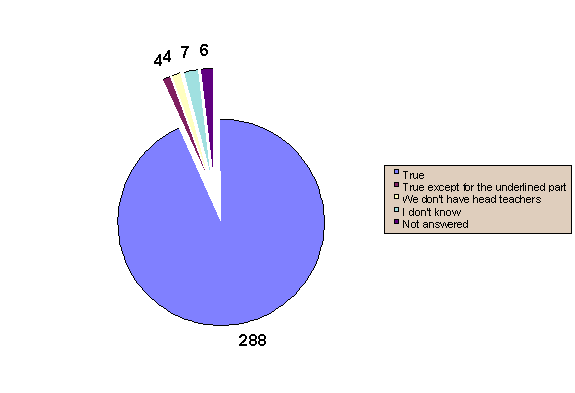
Comments
The fact that teachers acknowledge the professionalism of their leaders shows that the management in nearly all of the language schools (that took part in the survey) includes at least one highly respected member. This shows that even in schools where the owners may not be professionals themselves, they have made sure that they put professional matters in the hands of a respectable DOS.
Criterion 34: Tape-recorders
“There is a tape-recorder available for each lesson.”
Regional average: 98%
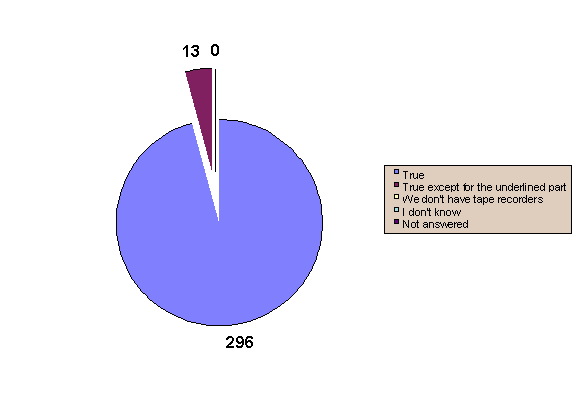
Comments
Not a surprising result as tape-recorders are fortunately cheap and easily available. The item did not inquire about the quality or the features of those tape-recorders (i.e. sound quality, counter), which, given the current development of technology, could also be considered quality criteria.
Criterion 24: Teachers’ qualifications
“Most of my colleagues are qualified teachers of the language they teach.”
Regional average: 97%

Comments
Unfortunately the item was not formulated very well: without the underlined part it could mean less than most, or the opposite, all. Still, by question 24 respondents may have detected that “true without the underlined part” probably meant something worse than “true” and answered the question as intended, which is the first sense. A high average, which shows that the schools involved employ nearly exclusively qualified staff.
Criterion 25: Colleagues’ language competence
“Most of my colleagues speak the language they teach excellently.”
Regional average: 95%

Comments
Same problem as in previous item. Nevertheless, a very high average; teachers believe that their colleagues’ language competence is excellent.
Criterion 30: Information office
“The school has an efficient office where students can get all the information about their courses.”
Regional average: 95%
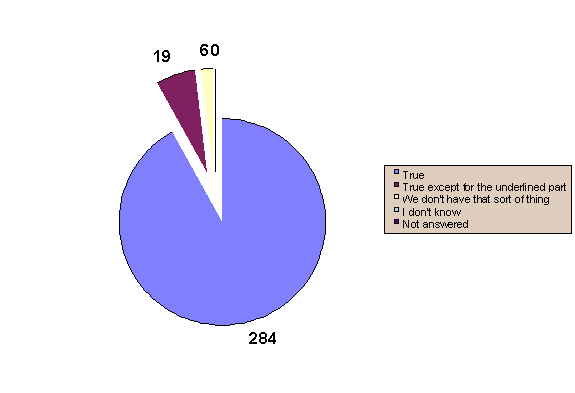
Comments
The high result is not surprising as schools would not be able to survive very long without an efficient office. By the time they reach a stage where they get in touch with a national quality organisation (which is how they became involved in the present study), an efficient customer office usually exists.
Criterion 27: Substitution
“If teachers are ill or cannot teach a lesson for some reason, lessons are always covered or made up for.”
Regional average: 94%
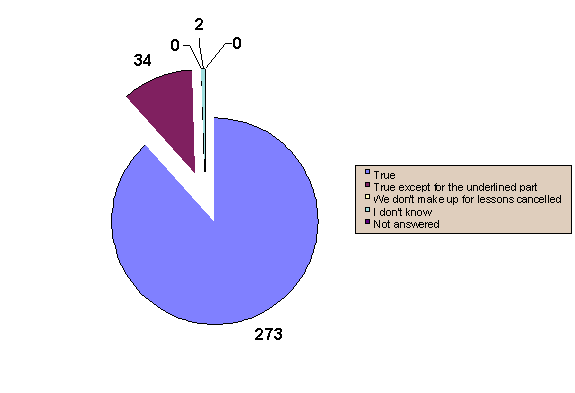
Comments
A high average, although 11% of respondents did not feel that the adverbial “always” suitably described reality, which shows that there are schools where substitution is not a natural part of school routines. On the other hand, an efficient substitution system is a key quality criterion, as one of the guarantees of honest customer service (i.e. that students get as many hours of teaching as they paid for).
Criterion 11: Exit tests
“Students are always given an achievement test when they complete a level.”
Regional average: 94%

Comments
The high average shows that giving exit tests is common practice. Apart from professional considerations, exit tests are usually needed by the school anyway in order to determine whether students have reached a level that is necessary for them to move on to the next course.
Criterion 28: Contracts
“I have an official written work contract with my school.”
Regional average: 92%
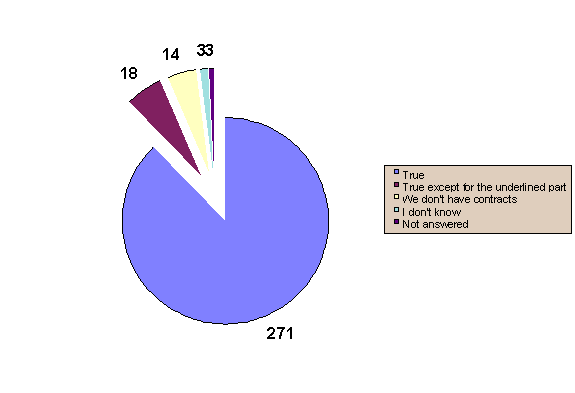
Comments
Although the regional average is high, the data show that 11% of teachers do not have a written contract with their school (what they might have instead is perhaps an oral contract). In most countries written work contracts are required by law. In the case of this item we remark that according to this criterion the countries involved fall into two groups: 27 out of the 32 responses that indicated lack of a written contract (B or C) came from Yugoslavia (10), Bulgaria (10) and Romania (7). In these three countries the contract situation does not fall into the “excellent” category.
Criterion 16: Head teachers’ approachability
“The head teacher(s) is (are) always easy to approach with professional questions and problems.”
Regional average: 92%
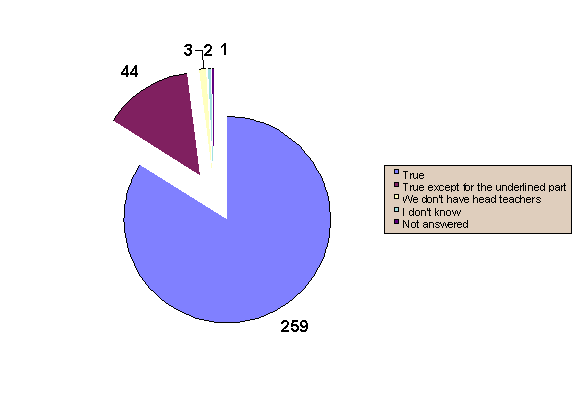
Comments
Whereas Criterion 15 (above) showed that head teachers (DOS’s) are highly respected professionals, their availability for professional discussions is somewhat less highly marked. 15% of teachers (one in every 7) do not always get a chance to talk to them when they want to – but 85% are satisfied.
Criterion 26: Overall trust
“I would happily send my own children to study in any of my colleagues’ groups.”
Regional average: 90%
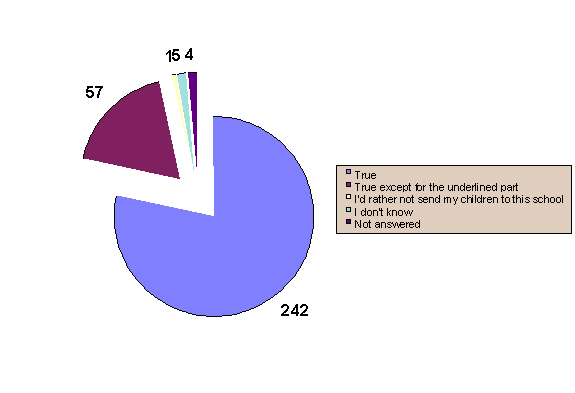
Comments
This item is supposed to measure the teachers’ overall trust in the professional quality of the school in which they teach. 90% is a high overall result, but we need to note that still 18% of teachers (one in every 6) would not send their children to the school where they teach unless they first had a chance to see who is going to teach them. This means that they do not believe that the school is able to guarantee institutionally the best possible service for their children. On the other hand, 82 per cent of teachers do trust their schools completely.
Criterion 12: End-of-course certificates
“Students are always given a certificate providing information on their achievement at the end of each course.”
Regional average: 90%
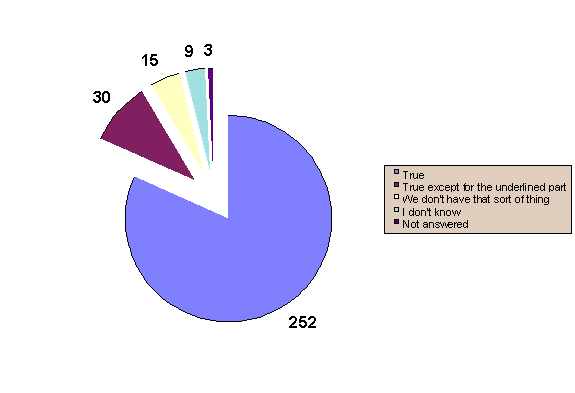
Comments
End-of-course certificates are one (but not the only) way of giving students feedback on their achievement. In most cases these certificates are linked to the exit tests (cf. Criterion 11 above). End-of-course certificates may also form part of the school’s PR; it may be turned into a nice-looking and precious document that carries the logo of the school. The data show that most schools have recognised their significance.
Criterion 1: Entrance tests
“Students in my school are always given a written placement test when they enter.”
Regional average: 90%
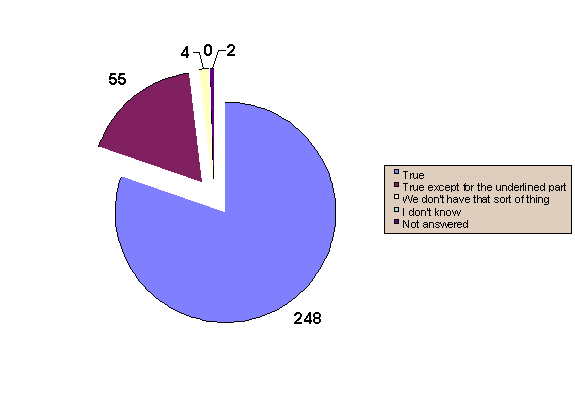
Comments:
Quite unfortunately, this item does not exclude total beginners, as it ought to. Therefore the 55 respondents who did not accept the “always” adverbial might have done so in order to indicate that total beginners were not tested – and they need not be. For this reason the results in the case of this item cannot be interpreted in the usual way. Had total beginners been properly excluded, the result might have been higher.
Criterion 9: Supplementary materials
“My school library has a comprehensive, professionally adequate collection of supplementary materials.”
Regional average: 89%

Comments
It is good to see that nearly all teachers reported that their school had a bank of materials, despite the fact that 18% of them are not satisfied with the quality and size of this collection. But most teachers are completely satisfied.
Criterion 31: Teaching rooms
“All of our rooms are appropriate for language teaching.”
Regional average: 88%

Comments
Although the regional average is relatively high, 24% of teachers (1 in every four) have indicated that not all of the rooms that their school uses are appropriate for language teaching (i.e. some of them are not). This may be useful information for school managers in the region, who might wish to make an effort to ensure that all lessons are held in a suitable physical environment.
Criterion 2: Needs analysis (of students)
“My colleagues always explore students’ needs before and during the language courses.”
Regional average: 86%
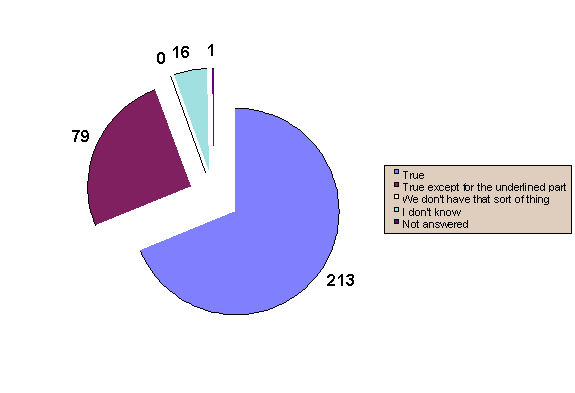
Comments
The question was, unfortunately, not formulated very well; it should have said “all the teachers in my school” or “it is the school’s policy to...” explore student’s needs. The high number of “I don’t know” answers may indicate either that some teachers did not know what their colleagues were doing (and indeed, why should they), or it was not clear to them what kind of needs analysis was referred to. Nevertheless, the vast majority indicated that some sort of needs analysis was carried out in the school.
Criterion 20: Post-observation discussion
“After the visits I am always given a chance to give and receive professional feedback.”
Regional average: 86%

Comments
Post-observation discussions, if carried out professionally, are generally considered to offer good opportunities for teachers to improve the quality of their teaching. They seem to be common practice in the vast majority of schools, although 8% of teachers indicated that this “sort of thing” was not done. Another 11% reported that it did not always happen. The results are still relatively high.
Criterion 10: audio & video resources
“My school has a wide range of audio and video materials.”
Regional average: 86%
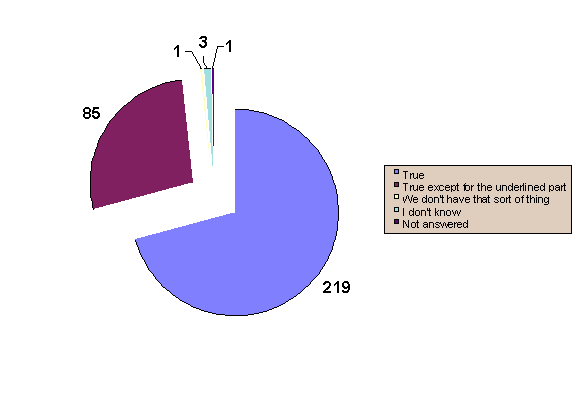
Comments
According to the teachers, all schools have such materials, yet 28% of them would like to see even more audio and video materials available for teaching purposes.
Criterion 35: Photocopying
“Teachers can use the school’s photocopier for producing material within a clear quota system.”
Regional average: 86%

Comments
This item differs from the others in the sense that in this case the second answer (“true without the underlined part”) does not necessarily imply lower quality, since the lack of a quota system may in fact make the teacher’s job easier (copying as much as they like); it may only cause extra costs for the school management (which, however, may reduce the resources available for other purposes such as development, but this is a very hypothetical assumption). It is certainly good to see that photocopiers are available to teachers (with or without quotas) in the vast majority of schools. It must be noted that 9 out of the 10 “we don’t have a photocopier” answers came from Yugoslavia (quite possibly the very same school).
Criterion 22: Support for external professional events
“The school offers its teachers financial support if they want to take part in professional workshops or conferences outside the school.”
Regional average: 84%
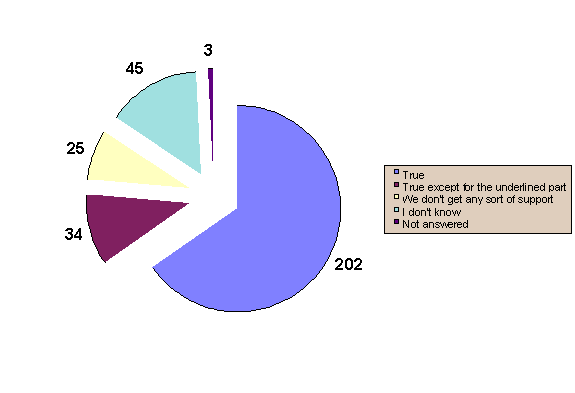
Comments
It is definitely good news for the teachers that 65% of the respondents are able to receive financial support from their schools for professional events. Of the remaining 35% some probably get some other type of support (possibly coverage of lessons missed or moral support), but some get none at all. The number of “I don’t know” answers is quite high (15%), which may mean that either they have never asked for such support before, or that the school never informed them of such issues – which, in fact, is partly the responsibility of the school management.
Criterion 8: Library
“My school has a library where I can access all the books and dictionaries I need for my teaching.”
Regional average: 83%
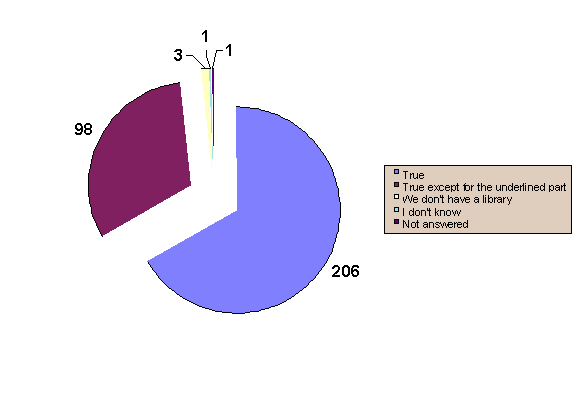
Comments
The results show that nearly all schools have a library, which is excellent. (The 3 “we don’t have a library” answers all arrived from Bulgaria, possibly representing one single school.) On the other hand, one third of the teachers are not completely satisfied with the size of the school library.
Criterion 13: Student feedback (school-level)
“The students’ opinion about the course and the school is regularly requested, using a written questionnaire.”
Regional average: 82%
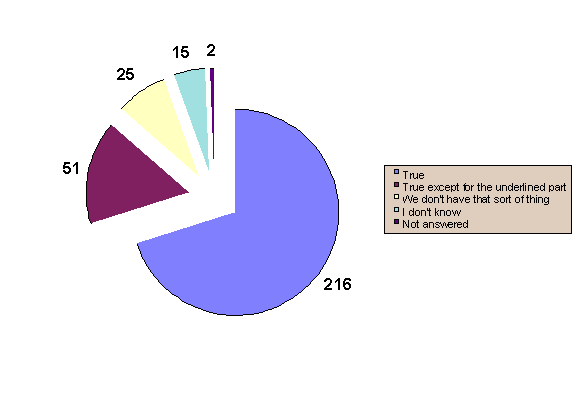
Comments
Student feedback is a device for the school management (and also the teacher) to measure customer satisfaction. The need to do it in writing usually arises when the size of the school no longer permits such information to flow through informal channels. Student feedback may also contribute to the professional development of the teachers and the management. 69% of teachers have reported that their school uses written student feedback forms. A further 17% regularly request the students’ opinions but this is not done in writing. Another 13% said either that the students’ opinion is not requested or that they don’t know anything about it.
Criterion 5: Complaints
“In my school there is an efficient system for dealing with complaints.”
Regional average: 82%
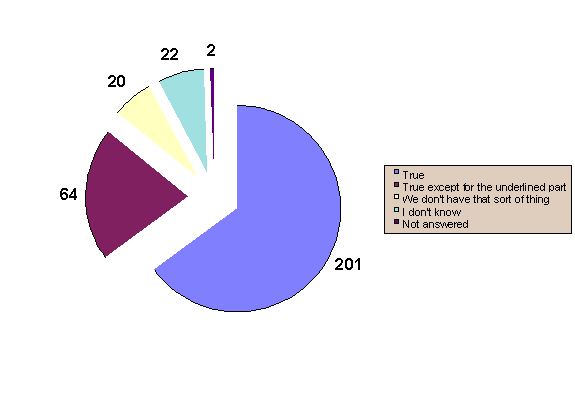
Comments
86% of the respondents have responded that there is some sort of system in their school for dealing with complaints; three-quarters of them believe that this system is efficient. The 6% who have said that their schools have no such system are a bit of a surprise: it is in the interest of profit-oriented services to have an efficient system to deal with complaints.
Criterion 29: Job description
“Teachers are given a written job description clearly listing their rights and obligations.”
Regional average: 81%

Comments
72% of the teachers get written job descriptions and another 17% are apparently informed of their rights and duties orally. The 10% who get no such information probably act according to some sort of common understanding of what they are supposed to do. Similarly to Criterion 28 (contracts), the job description situation is less good in Bulgaria, Romania and Yugoslavia. This is not surprising as job descriptions are related to contracts; they may form part of them or be an appendix to them.
Criterion 6: Syllabus
“A carefully worked-out written syllabus is available for each group/course I teach.”
Regional average: 81%
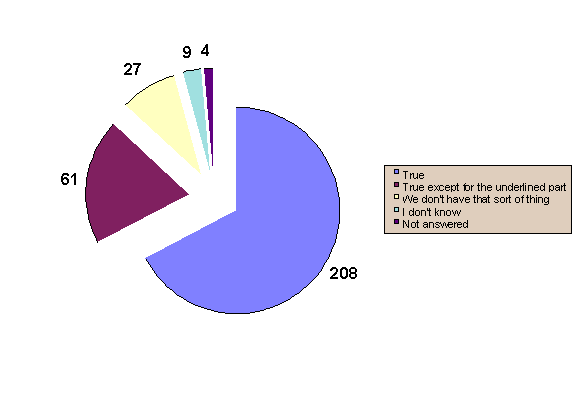
Comments
In two-thirds of the schools a written syllabus is available for each course. 20% have syllabi which may not be written or may be of poor quality, according to the teachers. But 9% of teachers have reported not having syllabi for every course (although they may still have them for some). It is almost impossible that any sort of teaching could go on without a syllabus, therefore it must be supposed that even in cases where “we don’t have that sort of thing” was reported some syllabi are agreed on – perhaps they are not written down, or perhaps the contents of the course-book is considered to be the syllabus.
Criterion 18: First visit
“A
member of the academic management came to see one of my lessons within
my first month
at the school.”
Regional average: 80%
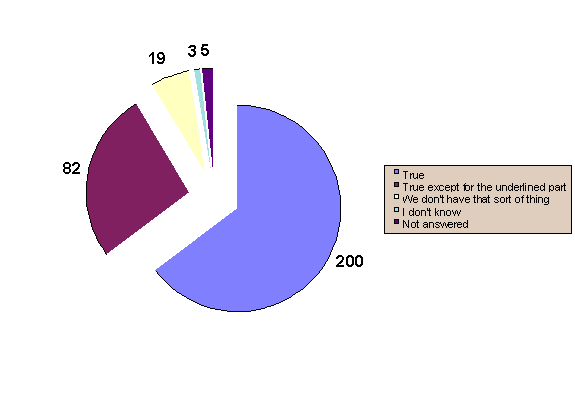
Comments
Observations/visits are one of the tools that enable the school management to control the quality of teaching. It is particularly important that the school management checks the quality of teaching very soon after a new teacher has been employed, since job interviews do not offer an opportunity for the school management to get an impression of the actual teaching style of the applicant (demo/trial teaching, which could fulfil this function to a limited degree, does not seem to be common practice, according to my experience). 64% of the teachers have had such a visit, whereas another 27% were probably visited later. 6% reported not having “such a thing” in their school.
Criterion 7: Logbooks
“When I have to substitute, I always find documentation of the previous lesson because we have a working logbook system.”
Regional average: 80%

Comments
According to the teachers, in 65% of the schools the logbook system guarantees smooth substitution if a teacher needs to be covered for. 25% of the teachers do not believe that the logbook system in their school will always guarantee that teachers get the relevant information in time. Another 7% reported not having logbooks at all. This is a criterion whose satisfaction may depend on the size of the school; very small and informally organised schools may be able to survive without documentation of lessons (sick teachers may talk to their colleagues over the phone) but larger organisations cannot survive without some sort of logbook system that guarantees the easy accessibility of such information.
C. Criteria that “need to be worked on”
Criterion 21: Internal training
“There are regular internal training workshops in the school.”
Regional average: 76%
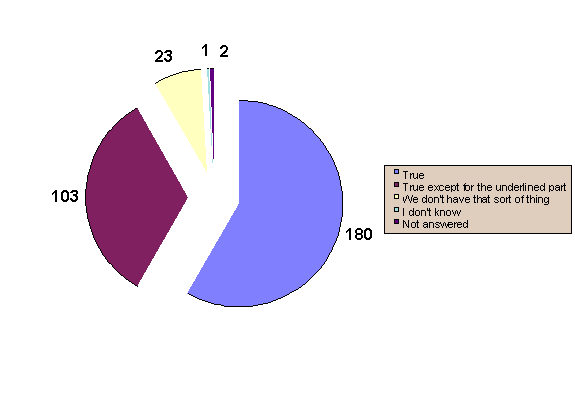
Comments
Internal training workshops are generally considered to be an important means of not only improving professional standards but also of increasing team spirit among teachers. If they get a chance to exchange their views on teaching and to have professional debates, they will learn more about each other, and the school will gradually acquire a distinguishable professional profile. According to the data, most school managers have recognised this, as 59% of teachers reported regular internal training workshops, and another 33% irregular ones. 7% of teachers do not get such an opportunity at their school. On the whole (adding up the latter two), however, 40% of the teachers do not get regular professional workshops.
Criterion 32: Teachers’ room
“There is a pleasant staff room for teachers where teachers can talk and prepare for their lessons.”
Regional average: 75%

Comments
Altogether 85% of teachers reported having a teacher’s room where they can prepare for their lessons and talk, although more than a quarter of them would like to have a more pleasant teacher’s room. But 14% work in schools that do not offer them a staff room; one wonders where these teachers prepare for their lessons (perhaps outside school).
Criterion 33: Computers
“Teachers can use a computer in the school any time.”
Regional average: 74%
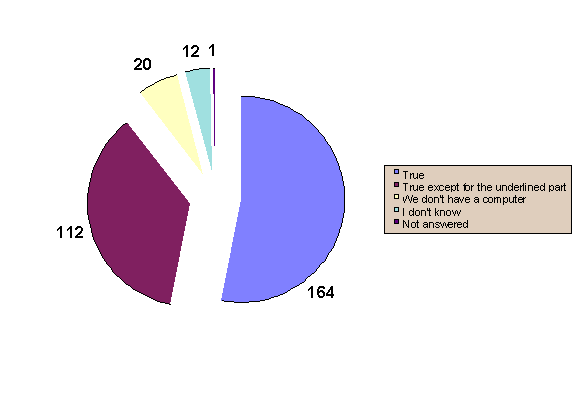
Comments
It is certainly very good to see that 90% of teachers have access to computers in their schools, but their access is limited in many cases. Unfortunately 6% do not have access to a computer at all. It should not be thought that excellent language teaching is not possible without computers, but computers can become an extremely useful professional tool in the hands of a language teacher.
Criterion 19: Observations
“A member of the academic management observes my lesson twice a year.”
Regional average: 74%

Comments
Two observations per year are more of an ideal situation than an absolute necessity. It is, of course, up to the school management to decide how many visits they consider necessary to achieve their quality objectives. It is in fact very reassuring that 88% of teachers are more or less regularly visited by DOS’s, both from a professional and a quality point of view. But 10% of respondents (31 teachers) appear not to have “such a thing”, i.e. lesson observations by a member of the academic management. In fact 27 of those responses came from Bulgaria (20) and Romania (7), which may show that we are dealing with isolated cases (perhaps a few schools only) rather than with trends.
Criterion 4: Information to students
“Students are given written information about their rights and obligations when they enter.”
Regional average: 73%
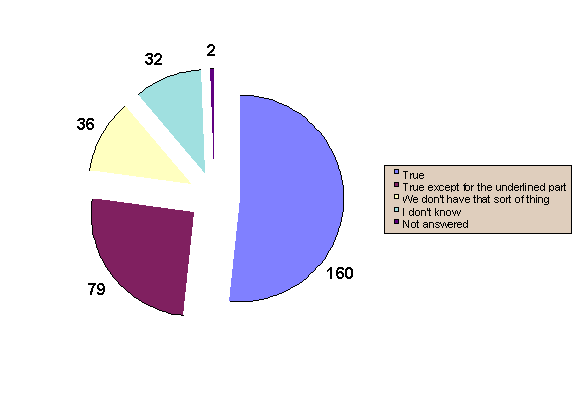
Comments
It is in fact usually a legal requirement that students (like all customers of any service) should be informed of their rights and obligations. Ideally, this should be done in writing, which appears to happen in the schools of 51% of the teachers. In another 26% of cases this is probably done orally, but 12% of teachers know of no such thing in their school. If this is true, it is a major deficiency of customer service which needs to be improved. (To give these teachers the benefit of the doubt, it may be the case that they do not really know how students are informed by the customer service office, in which case they should have in fact marked “I don’t know” rather than “We don’t have that sort of thing”.)
Criterion 3: Oral tests
“Higher-level students in my school are always given an oral interview when they enter.”
Regional average: 72%

Comments
Oral interviews are normally used to fine-tune the results of a written placement test (cf. Criterion 1 above) in the case of higher-level students, whose oral skills may differ from their written skills, which may modify the decision about their placement. This happens regularly in the schools of 52% of the teachers, and less regularly in the schools of 24%. 13% of teachers have indicated not having this “sort of thing”, i.e. oral interviews, which may make the placement process less reliable.
Criterion 17: Job interview
“When I joined the school, I had an interview in the language that I teach.”
Regional average: 69%
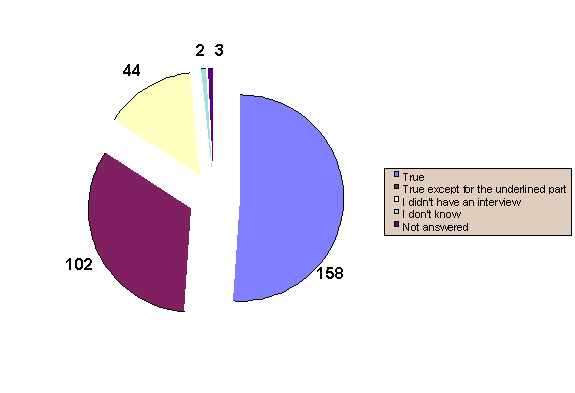
Comments
A job interview is usually a key stage in the decision-making process about employing new staff in any sort of job. Getting a job without an interview, which seems to have happened to 14% of our respondents, only seems possible A) if the employer had information on the professional skills of the employee through informal channels (personal references, personal contact, ex-student, etc.); B) if the informant is the employer himself/herself; or C) if there is professional neglect on the employer’s part. It may also happen that the candidate demonstrates his/her skills not in an interview but in some other way, e.g. in a demonstration lesson. In the case of a language teacher the command of the foreign language that the employee intends to teach is probably the first and foremost thing an employer might wish to verify. This is why it is surprising that the interview is not conducted in the target language in nearly 40% of those cases when there is an interview. (Some employers may consider a teacher’s degree a satisfactory guarantee of high-level language skills; on the other hand, in countries with liberalised higher education, such as Hungary, this is not always the case, which is why associations insist on interviews in the target language as a guarantee of quality.)
Criterion 14: Consultation for students
“My school offers a regular consultation opportunity to individual students in addition to the language programme.”
Regional average: 69%
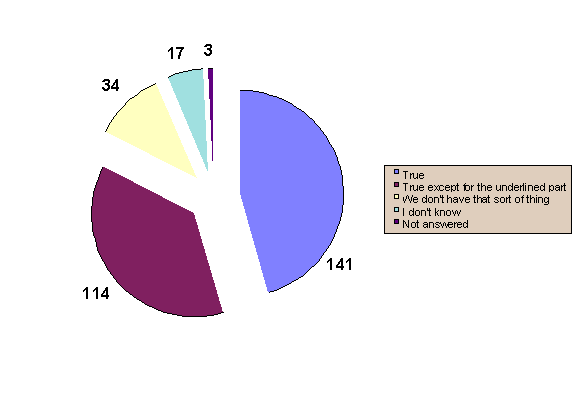
Comments
Consultations are not an indispensable element of customer service in a language school but they may offer very useful supplementary opportunities to students. Whether or not they are offered free of charge (as part of the course) was not inquired about in this item. Most schools probably cannot afford to offer this service free of charge, which may be why only 45% of teachers have reported that consultations are offered on a regular basis. There is no such thing in the school of 11% of the teachers.
Criterion 23: Teachers’ self-assessment
“Self-assessment is carried out by the teachers on a regular basis.”
Regional average: 67%
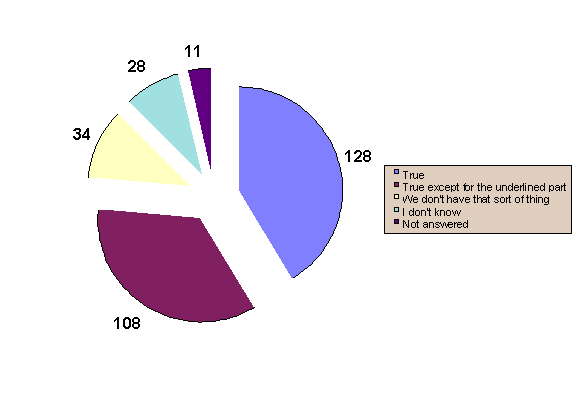
Comments
A
remarkable 13% of teachers did not answer this question or marked “I
don’t know”. The reason may be that the sentence was not formulated
very well, as here the informant was in fact asked about what other teachers
were doing, which they cannot really be expected to know. Self-assessment
may be a very private thing but it may also be demanded by the school
management. It may also be the case that some teachers were not sure what
self-assessment meant.
In my analysis of the results I tried to show not only the outcome of this international survey but also the weaknesses of some of the items (as well as of the whole concept). I repeat here that one must treat the results of this survey with extreme caution, as the methods that were used for collecting the data were not advanced enough to enable the analyst to make far-reaching claims.
In conclusion I will make a list of the most remarkable findings.
According to the teachers in six countries of Eastern Europe...
Most schools have excellent head teachers, who are easy to approach.
Tape-recorders are available everywhere.
Nearly all schools have a library and a collection of supplementary materials.
Language schools employ mostly qualified staff with good target-language
skills.
Customer service is very good.
Substitution of sick teachers is common practice.
Students are regularly tested at entrance and exit.
90% of teachers have access to computers.
88% of teachers are more or less regularly visited by the academic management.
11% of teachers do not have a written contract with their school, and
27% do not receive a written job description about their rights and obligations.
14% of teachers do not have a common room where they can prepare for lessons
and talk.
24% of teachers do not believe that all of their school’s rooms are
suitable for language teaching.
28% of teachers are not fully satisfied with the range of audio and video
materials of the school.
20% of teachers do not receive financial support from their schools if
they wish to take part in professional conferences or workshops outside
the school.
29% of teachers do not always receive a written syllabus for the course
they teach.
32% of teachers do not have logbooks or do not believe that the information
in the logbooks will guarantee problem-free substitution.
40% of teachers do not receive regular internal training.
14% of teachers did not have a job interview, and 40% of those who had
one did not have it in the target language.
![]()
